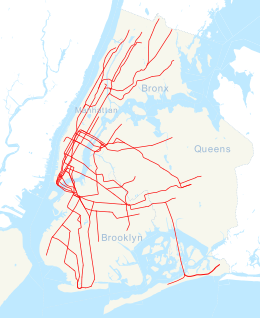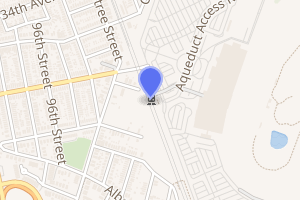Aqueduct Racetrack station
Aqueduct Racetrack is a station on the IND Rockaway Line of the New York City Subway. Located on the west side of Aqueduct Racetrack near Pitkin Avenue in Ozone Park, Queens, it is served by northbound A trains at all times.[5]
Aqueduct Racetrack | |||||||
|---|---|---|---|---|---|---|---|
The single platform at Aqueduct Racetrack | |||||||
| Station statistics | |||||||
| Address | near 98-00 Pitkin Avenue Queens, NY 11417 | ||||||
| Borough | Queens | ||||||
| Locale | Ozone Park | ||||||
| Coordinates | 40.672086°N 73.835914°W | ||||||
| Division | B (IND, formerly LIRR Rockaway Beach Branch) | ||||||
| Line | IND Rockaway Line | ||||||
| Services | A | ||||||
| Transit connections | |||||||
| Structure | Embankment | ||||||
| Platforms | 1 side platform | ||||||
| Tracks | 4 (2 in passenger service) | ||||||
| Other information | |||||||
| Opened | September 14, 1959[1][2] 1997 (first reopening) August 13, 2013 (second reopening) | ||||||
| Closed | Between December 1991 and March 1992 (first time) April 28, 2011 (second time) | ||||||
| Station code | 196[3] | ||||||
| Accessible | |||||||
| Opposite-direction transfer available | Yes | ||||||
| Traffic | |||||||
| Passengers (2019) | 601,436[4] | ||||||
| Rank | 400 out of 424[4] | ||||||
| Station succession | |||||||
| Next north | Rockaway Boulevard: A | ||||||
| Next | Euclid Avenue: A | ||||||
| Next south | no southbound service Next station: Aqueduct–North Conduit Avenue: A | ||||||
| Next | no southbound service Next accessible station: Howard Beach–JFK Airport (via Rockaway): A | ||||||
| Notes | Southbound trains do not stop at this station | ||||||
| |||||||
| |||||||
| |||||||
The station was built in 1959 to serve the racetrack and on racing days the station would be open with "Aqueduct Special" trains running nonstop from 42nd Street. The specials were replaced by JFK Express service, before service at the station was altogether discontinued in 1992. The station reopened in 1997. From 2011 to 2013, it was closed and rebuilt in order to provide better access to the Resorts World Casino.
Aqueduct Racetrack is one of the least-used stations in the system. It was ranked 385th out of 424 by ridership as of 2018, with 732,091 passengers.
History
The Rockaway Line was opened on August 26, 1880 by the New York, Woodhaven and Rockaway Railroad and would later be operated by the Long Island Rail Road (LIRR) as its Rockaway Beach Branch.[6][7]:14 Frequent fires on the line's wooden viaduct across Jamaica Bay between The Raunt and Broad Channel made the line a liability for the LIRR. After a fire on May 8, 1950 cut service, the bankrupt LIRR sought to sell or abandon the line altogether.[8][7]:68 The city purchased the southern portion of the line in 1952.[9] The rebuilt IND Rockaway Line opened for subway service on June 26, 1956.[7]:68[10][1][11][12]
In 1955, the New York Racing Association chose to upgrade Aqueduct Racetrack in South Ozone Park in part because of its proximity to the Rockaway Beach Branch. As part of the modernization of the racetrack, the Racing Association built a station with ramps leading directly to the track and facilities that could handle racetrack crowds. Once the work was finished, it was handed over to the city.[13] The new station was for northbound trains to Brooklyn and Manhattan, and it was built north of the existing Aqueduct station.[10][14] In order to allow for the switching maneuvers required for southbound trains to stop at the station, major signal changes were made on the line.[13] The single-platform station was built by Aqueduct Racetrack owners at the cost of $1 million.[1][2][15] The Aqueduct Racetrack station opened on September 14, 1959, on the same date as the renovated Aqueduct Racetrack.[1][2][15]
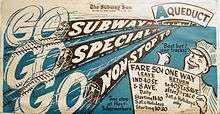
On the start of service in September 1959, extra-fare "Aqueduct Special" trains ran nonstop from the lower level of the 42nd Street–Port Authority Bus Terminal in Manhattan until it crossed over to the northbound platform to discharge passengers at the racetrack.[1][15][16] A trial run took place on June 2, 1959, with the running time to the track being about 29 minutes.[17][18] Transit officials said that the actual time of the specials would be thirty minutes at a minimum as the pace of the train was too swift. Aboard the train were 200 members of the National Association of State Racing Commissioners.[19] The fare was initially 50 cents.[13][20][21] One train, on weekdays and Saturdays, left from the Hoyt–Schermerhorn Streets station. That station's now-closed outer platforms were used to segregate passengers using the special service.[15] Later on, all trains would stop at Hoyt–Schermerhorn Streets.[21][22][23] On September 22, 1959, the New York City Transit Authority added five "Daily Double" trains on weekdays and eight on Saturdays, doubling the original number of trains.[24] The Aqueduct Special reduced travel time between Manhattan and the racetrack to 35 minutes.[25]:II-6 Return trips would operate on Saturdays and holidays.[21][26][27]
Increased service was provided during the 1960 spring meeting with Saturday and holiday service. During its first year, the service carried 341,000 riders.[13] During the 1960s the extra fare was collected at special turnstiles at the three stations served by the special. Larger tokens were used.[lower-alpha 1][31][29] On July 5, 1966, the fare on the Aqueduct Special was raised to 75 cents.[32][33] The fare was raised to $1 on January 4, 1970.[34] The fare was raised from a $1 to $1.50 in February 1972.[35] Later on the fare was lowered back to $1.[31] The fare was raised back to $1.50 on June 28, 1980.[36]
Beginning on April 15, 1978, during racing season one train ran from 57th Street on the IND Sixth Avenue Line to Aqueduct Racetrack, leaving 57th Street at 11 A.M. and arriving at Aqueduct at 11:35 AM. The train left for the return trip after the final race.[31][37]
In September 1978, the JFK Express began service and stopped at this station on racing days.[lower-alpha 2][39] The Aqueduct Specials ceased operation altogether in October 1981.[40][41] At the time of their discontinuance the fare was $3, and it was being replaced by the more expensive $5 JFK Express fare.[42] Between December 1991 and March 1992,[43] after the JFK Express was discontinued, the Aqueduct Racetrack station was closed throughout the day, not reopening until the summer of 1997.[44][45] The remaining service along the line would only be scheduled to stop on race days between 11 a.m. and 7 p.m.,[46][47][48] though some trains stopped here regardless of the time of day.[49] In the summer of 1997 the station became one of the first in the system to have Metrocard-only High Entrance/Exit Turnstiles.[44]
On April 28, 2011,[50] the station was closed and underwent a $15 million renovation. This renovation was sponsored by the Resorts World Casino (or "Racino"), which had opened at the racetrack in 2011 and wanted to create a direct connection from the station to the casino.[51] The station was scheduled to reopen in early 2012, but was delayed.[52] The renovation added new staircases to street level, an enclosed passageway between the station and casino, and an elevator from the street to platform level to make the station ADA-accessible. The station reopened on August 13, 2013, and now operates 24 hours a day.[49][53][54][55] In 2013, there was a proposal to rename this station to Aqueduct–Resorts World Casino[53][54][56] and to add a platform for Rockaway-bound trains.[54] As of July 2012, the Metropolitan Transportation Authority (MTA) has withheld approvals to construct a southbound platform.[48][52]
Station layout
| East Mezzanine | Station house, fare control, street level access, walkway to Aqueduct Racetrack | |
| P Platform level |
Side platform | |
| Northbound local | ← | |
| Northbound express | Trackbed | |
| Southbound express | Trackbed | |
| Southbound local | | |
| G | Street level | Aqueduct Road and Pitkin Avenue exit/entrance |
Located on an embankment, the station has four tracks with only the outer two used in revenue service. The two center express tracks have been disconnected from the line and permanently removed.[47]:PDF p. 162[57]:54 North of this station, a portion of the southbound express track connects with the southbound local track at its north end, and ends at a bumper block at its southern end. This section of track can be used for revenue service or work train layups, but this use has been made completely redundant because of the nearby Pitkin Yard serving as the primary layup yard instead. North of the station, the line's northbound track switches to the position of the former southbound express track to head onto the Liberty Avenue elevated structure.[57]:54
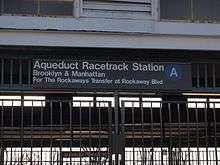
The station is the only through stop in the New York City Subway to serve trains in a single direction.[lower-alpha 3] There is one side platform located on the northbound side, with one exit leading directly to Aqueduct Racetrack, [59] serving northbound trains[47][49] heading toward Brooklyn and Manhattan. Southbound trains do not serve the station but stop at the Aqueduct–North Conduit Avenue station a short walk south. In the past, southbound trains have terminated at this station[13] using a crossover located to the north of the station.[60] This station was originally advertised as "open on racing days", but some trains stopped here regardless of the time of day; riders could not always exit the station, depending on whether the racetrack was open.[49]
Exits
This station has four High Entrance/Exit Turnstiles and several emergency exit gates (one of which is equipped with an AutoGate MetroCard reader), but no station agent's booth or MetroCard Vending Machines.[61] Although MetroCards can technically be purchased at any subway station in the system,[61] the Metropolitan Transportation Authority (MTA) considers the station to be linked with Aqueduct–North Conduit Avenue located approximately 1,500 feet (460 m) to the south, which has a full-time station agent's booth and MetroCard machines.[61][62] Two wide staircases and the elevator lead down from platform level to the parking lots in front of the racetrack.[54][63] A sidewalk on the western side of Aqueduct Road leads south from Aqueduct Racetrack to the North Conduit Avenue station; the main fare control area is located at the south end of that station at North Conduit Avenue.[61] At the north end of the passageway at Pitkin Avenue is a gate which, when open, allows access between the station and racetrack and the local community.[54] The glass-enclosed bridge, called the "SkyBridge", is temperature-controlled and provides another ADA-accessible entrance into the station.[63] It leads directly to the Resorts World Casino.[53][59] Formerly, the only entrance to the station was through a large wide passageway (similar to those at Mets–Willets Point), which led directly to the racetrack.[1][47]
Ridership
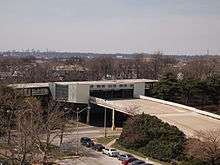
Due to the fact that it mainly serves Aqueduct Racetrack, the station is not well-used compared to other stations in the system. During the 1970s ridership at the station declined, from 1.1 million passengers in 1975 to 573,000 in 1979.[25]:II-5
In 2005,[47]:PDF p. 163 2006,[47]:PDF p. 163 2007,[47]:PDF p. 163[64] and 2009,[64] the station was the second least used station in the system (and the least used station that was open for use).[lower-alpha 4][64][65] As of 2007, ridership was higher on Saturdays than on weekdays (with an average of 58 riders on weekdays and 895 on Saturdays).[47]:PDF p. 163
In 2009, the station had 27,004 entries,[66] making the station among the system's least-used.[67] This amounted to only 52 boardings per weekday in 2009, representing a 71.6 percent decrease from the station's 1990 ridership.[65]:2 In 2010, there were 29,644 recorded entries, and in 2011, there were 54,183 entries.[66] Since the station was closed through 2012, there were no boardings, but after full-time service was restored to the station in 2013, there was a significantly higher ridership, with 213,601 recorded entries in 2013 and 630,644 entries in 2014.[4] The increase in ridership at the station and the nearby Aqueduct–North Conduit Avenue station since 2010 has been attributed to the end of off-track betting at the racetrack in 2010,[47]:PDF p. 162[62] and the opening of the casino in 2011.[52][62]
In 2016, the station had 676,971 boardings (up from 672,734 in 2015), making it the 392nd busiest station in the 422-station system. This amounted to an average of 1,739 passengers per weekday.[4]
Notes
- One of the tokens issued was a 28 mm (1.1 in) token, which was used only for Aqueduct Specials from 1966 to 1980.[28][29] Another "special" token, which was 23 mm (0.91 in), was only used for a short time period in the early 1980s.[29][30]
- This is also evident in the following image, in which a JFK Express train is stopping at the station, and there is a sign indicating where the train stops at the platform.[38]
- Although Dyckman Street on the A train, 145th Street on the 3 train, and 238th Street on the 1 train all have two platforms, neither station has entrances on the northbound side. However, northbound passengers are allowed to leave the train at these stations. The loops at City Hall and South Ferry are closed, but they are terminal stations. The New York City Subway map shows that Aqueduct Racetrack is the only non-terminal station that permanently and exclusively serves trains in one direction (excluding stations being renovated at the time).[58]
- These counts included Cortlandt Street–World Trade Center in Manhattan, which was closed for 17 years following the September 11, 2001 attacks, and as such had no ridership at all during that time.[4][64]
References
- "Fabulous $33 Million Aqueduct Track Ready". Buffalo Courier-Express. Fultonhistory.com. September 13, 1959. p. 7. Retrieved August 15, 2016.
- "Aqueduct Last Word in Luxury". Times Union (Albany). New York. Fultonhistory.com. September 6, 1959. p. B11. Retrieved August 15, 2016.
- "Station Developers' Information". Metropolitan Transportation Authority. Retrieved June 13, 2017.
- "Facts and Figures: Annual Subway Ridership 2014–2019". Metropolitan Transportation Authority. 2020. Retrieved May 26, 2020.
- "A Subway Timetable, Effective November 17, 2019" (PDF). Metropolitan Transportation Authority. Retrieved January 16, 2020.
- Baer, Christopher T. (March 2008). "PRR CHRONOLOGY, 1880" (PDF). prrths.com. Pennsylvania Railroad Technical and Historical Society. Retrieved December 4, 2016.
- George, Herbert (1993). Change at Ozone Park: A History and Description of the Long Island Rail Road Rockaway Branches. Flanders, New Jersey: RAE Publishing Incorporated.
- "L.I.R.R. Proposes Junking Trestle Ruined by Fire". Brooklyn Daily Eagle. May 31, 1950. p. 4. Retrieved September 22, 2015 – via Newspapers.com.
- Linder, Bernard (February 2006). "Rockaway Line". New York Division Bulletin. Electric Railroaders' Association. 49 (2): 3–4. Retrieved August 27, 2016.
- Freeman, Ira Henry (June 28, 1956). "Rockaway Trains to Operate Today" (PDF). The New York Times. Retrieved June 29, 2015.
- "First Train On Rockaway Line Runs This Afternoon". Wave of Long Island. Fultonhistory.com. June 28, 1956. p. 1. Retrieved August 16, 2016.
- "First Train On Rockaway Line Runs This Afternoon". Wave of Long Island. Fultonhistory.com. June 28, 1956. p. 6. Retrieved August 16, 2016.
- "TA's New Line To Rockaways Begins Today: Fifty Piece Band To Play as Special Train Makes First Run". The Leader-Observer. Fultonhistory.com. June 28, 1956. p. 1. Retrieved August 16, 2016.
- "To Rockaways: Beach Trains In Operation". Greenpoint Weekly Star. Fultonhistory.com. June 29, 1956. p. 2. Retrieved August 16, 2016.
- Hegarty, Matt (September 27, 2010). "Aqueduct casino operator makes $380M payment". Daily Racing Form. Retrieved October 17, 2015.
- Annual Report For The Year Ended June 30, 1960. New York City Transit Authority. June 30, 1960. pp. 20–21 – via Google Books.
- "Transit Agency Jockeys Over Aqueduct's Station" (PDF). The New York Times. July 15, 1955. Retrieved October 17, 2015.
- "Special Aqueduct Subway Service: Premium Fare Trains Started By T.A. To Local Race Track". Wave of Long Island. Fultonhistory.com. September 17, 1959. p. 5. Retrieved August 15, 2016.
- Cunningham, Joseph; DeHart, Leonard O. (January 1, 1993). A History of the New York City Subway System. J. Schmidt, R. Giglio, and K. Lang – via Google Books.
- June 2, 1959: George operates first non-stop subway express in transit history, racetrack Aqueduct Special. Railroad Magazine. 87–88. May 1970. p. 107. Retrieved December 1, 2016 – via Google Books.
- "Red Smith's Views of Sport". Buffalo Courier–Express. June 3, 1959. Retrieved December 3, 2016 – via Fulton History.
- Levey, Stanley (June 3, 1959). "IND RACING TRAIN GETS A WORKOUT; Makes It to Aqueduct From 42d Street in 28:43 – Track Opens Sept. 14". The New York Times. ISSN 0362-4331. Retrieved November 29, 2016.
- "How to Reach the Track by Subway, Rail and Autok". The New York Times. September 14, 1959. ISSN 0362-4331. Retrieved November 29, 2016.
- Annual Report 1962–1963. The New York City Transit Authority. June 30, 1963. p. 18 – via Google Books.
- Nichols, Joseph C. (March 18, 1962). "Thoroughbreds and Standardbreds Begin New York Racing Season Tuesday; SWIFT HIGHLIGHTS AQUEDUCT OPENING Donut King Among Possible Starters—Equinox Pace Heads Roosevelt Card A Rich Background Aqueduct Resumes Aug. 27". The New York Times. ISSN 0362-4331. Retrieved November 29, 2016.
- Cady, Steve (March 15, 1965). "For Hunch Players, the Time Is Now". The New York Times. ISSN 0362-4331. Retrieved November 29, 2016.
- "SUBWAY ENLARGES AQUEDUCT SERVICE". The New York Times. September 23, 1959. ISSN 0362-4331. Retrieved November 27, 2016.
- Nassau Expressway Construction, New York City: Environmental Impact Statement. Federal Highway Administration, New York State Department of Transportation. November 1981 – via Google Books.
- Nichols, Joseph C. (March 19, 1961). "The Tracks Are Ready, the Fans Are Poised – Bring on the Horses; Thoroughbreds and Standardbreds to Open New York Racing Tomorrow AQUEDUCT STAKES GETS FIELD OF 13 Globemaster, Merry Ruler in $25,000 Swift – Pace at Yonkers Worth $6,000". The New York Times. ISSN 0362-4331. Retrieved November 29, 2016.
- "Aqueduct Special Begins Today". New York and Brooklyn Daily. March 20, 1963. Retrieved December 3, 2016 – via Fulton History.
- "B Token of New York City Transit Authority, United States, 1966 – 1980. 1981.128.2". American Numismatic Society. Retrieved November 29, 2016.
- Cuhaj, George S. (Summer 2003). "Subway Token's Passing Just the Latest for NYC". ANS Magazine. Retrieved November 29, 2016.
- "B Token of New York City Transit Authority, United States, 1980. 1980.148.1". American Numismatic Society. Retrieved November 29, 2016.
- "MTA To The "Big A." It's The Way To Come In First. Brochure". Metropolitan Transportation Authority. April 1978. Missing or empty
|url=(help) - "Bettors Lose Again: Subway Special Is 75c". The New York Times. July 5, 1966. ISSN 0362-4331. Retrieved November 29, 2016.
- "Variations in Fare". The New York Times. July 5, 1966. ISSN 0362-4331. Retrieved November 29, 2016.
- Robinson, Douglas (January 3, 1970). "New Tokens Go on Sale in Subways". The New York Times. ISSN 0362-4331. Retrieved December 25, 2016 – via New York Times Archives.
- "Paumonok Handicap Highlights Opening Card at Aqueduct on Wednesday". The New York Times. February 27, 1972. ISSN 0362-4331. Retrieved November 29, 2016.
- "Old and New Commuter Fares in New York Area". The New York Times. June 30, 1980. ISSN 0362-4331. Retrieved December 3, 2016.
- Tuite, James (April 16, 1978). "Cox's Ridge, $3.40, Takes Excelsior at Aqueduct". The New York Times. ISSN 0362-4331. Retrieved December 4, 2016.
- Barnes, John (March 1990). "Image of the JFK Express stopping at Aqueduct Racetrack". nycsubway.org. Retrieved December 3, 2016.
- "New "JFK Express" Service Begun in Howard Beach". New York Leader Observer. Fultonhistory.com. September 28, 1978. Retrieved July 22, 2016.
- Jonathan Lethem (December 18, 2007). "3". The Disappointment Artist: Essays (PDF). Knopf Doubleday Publishing Group. pp. 43–58. ISBN 978-0-307-42840-0. Retrieved August 28, 2016.
- Crist, Steven (October 11, 1981). "John Henry and 8-1 Timely Writer Win". The New York Times. Retrieved October 12, 2009.
- Crist, Steven (October 14, 1981). "AQUEDUCT'S EYE ON THE AFFLUENT". The New York Times. ISSN 0362-4331. Retrieved November 29, 2016.
- Compare:
- "New York City Subway Map". Metropolitan Transportation Authority. December 1991. Retrieved December 1, 2016 – via Flickr.
- "New York City Subway Map". Metropolitan Transportation Authority. March 1992. Retrieved December 1, 2016 – via Flickr.
- Sheridan, Dick (September 23, 1998). "METROCARD-ONLY TURNSTILE MORE THAN TOKEN CHANGE". New York Daily News. Retrieved November 28, 2016.
- "A Subway timetable, between Far Rockaway or Lefferts Boulevard and 59th Street". Metropolitan Transportation Authority. September 1997. Missing or empty
|url=(help) - Compare:
- "New York City Subway Map" (PDF). mta.nyc.ny.us. Metropolitan Transportation Authority. July 1997. Archived from the original (PDF) on July 4, 1997. Retrieved December 1, 2016.
- "New York City Subway Map". Metropolitan Transportation Authority. September 1997. Retrieved December 1, 2016 – via Flickr.
- "Development and Operation of a Video Lottery Facility at Aqueduct Racetrack, Jamaica (Borough of Queens), New York" (PDF). New York Lottery, O'Brien & Gere. October 2010. Retrieved August 15, 2016.
- Pozarycki, Robert (July 26, 2012). "Seeking 'Big A' Station Fix: Pol: Put Project Back In The Saddle". Times Newsweekly. Archived from the original on September 11, 2016. Retrieved August 15, 2016.
- Guimaraes, Mayara; Donohue, Pete (August 8, 2013). "Aqueduct Racetrack stop on A train in Queens now running full time for easier casino access". New York Daily News. Retrieved October 16, 2015.
- Donohue, Pete; Guimaraes, Mayara (August 8, 2013). "Aqueduct Racetrack stop on A train in Queens now running full time". New York Daily News. Retrieved December 4, 2016.
- Bilefsky, Dan (October 27, 2011). "New York's First Casino, at Aqueduct Racetrack, Is Set to Open". The New York Times. Retrieved July 9, 2016.
- Rafter, Domenick (July 12, 2012). "Casino subway stop work remains stalled: Station was due to open months ago". Queens Chronicle. Retrieved August 15, 2016.
- Hayes, Maggie (October 15, 2013). "Resorts World Casino operators want to buy Aqueduct Racetrack subway station naming rights". qns.com. Retrieved October 16, 2015.
- Rafter, Domenick (August 14, 2013). "Take 'A' train to reach the games: Subway stop at Resorts World opens". Queens Chronicle. Retrieved October 16, 2015.
- Fortis, Bianca (August 15, 2013). "Racino train station now open full-time". Times Ledger. Retrieved August 15, 2016.
- Donohue, Pete (October 10, 2013). "Resorts World Casino may buy name of subway". New York Daily News. Retrieved July 9, 2016.
- Dougherty, Peter (2020). Tracks of the New York City Subway 2020 (16th ed.). Dougherty. OCLC 1056711733.
- "Subway Map" (PDF). Metropolitan Transportation Authority. October 21, 2019. Retrieved January 18, 2018.
- "MTA Neighborhood Maps: Ozone Park" (PDF). Metropolitan Transportation Authority. 2015. Retrieved October 16, 2015.
- Marrero, Robert (January 1, 2017). "472 Stations, 850 Miles" (PDF). B24 Blog, via Dropbox. Retrieved April 27, 2018.
- Kennedy, Randy (March 26, 2002). "Tunnel Vision; A $60 Subway Ride? Maybe, but He's Fighting It". The New York Times. Retrieved November 27, 2016.
- "Subway Ridership at Highest Levels Since 1950!". mta.info. Metropolitan Transportation Authority. February 27, 2012. Retrieved October 16, 2015.
- "Accessible Stations in the MTA Network". web.mta.info. Metropolitan Transportation Authority. Retrieved November 29, 2016.
- "Facts and Figures: Ridership (2010)". mta.info. Metropolitan Transportation Authority. 2011. Archived from the original on June 10, 2011. Retrieved August 15, 2016.
- "ECONOMIC SNAPSHOT: A Summary of New York City's Economy" (PDF). New York City Economic Development Corporation. June 2010. Retrieved August 15, 2016.
- "Facts and Figures: Ridership (2012)". mta.info. Metropolitan Transportation Authority. 2013. Archived from the original on July 7, 2013. Retrieved August 15, 2016.
- Schwach, Howard (April 30, 2010). "MTA: Fewest Riders At Four A-Train Stations". Wave of Long Island. Archived from the original on August 23, 2016. Retrieved August 15, 2016.
External links
| Wikimedia Commons has media related to Aqueduct Racetrack (IND Rockaway Line). |
- nycsubway.org – IND Rockaway: Aqueduct Racetrack
- The Subway Nut – Aqueduct Racetrack Pictures
- Entrance and skybridge to the casino from Google Maps Street View
